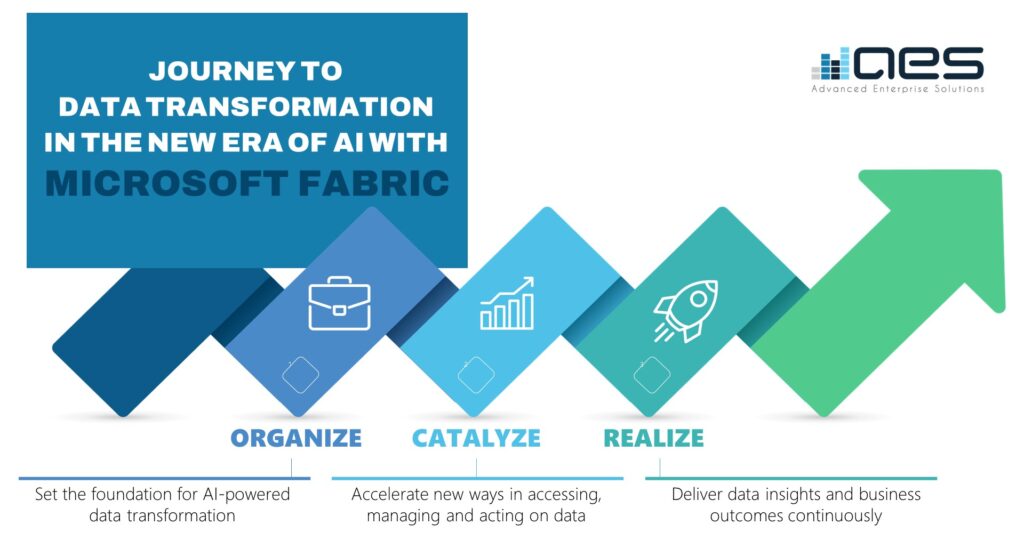The AES Group, in partnership with Playtime Solutions, has crafted a robust and comprehensive approach to help organizations resolve their data challenges, move to Microsoft Fabric and usher into their new AI-powered businesses. The Organize stage is the first critical step in implementing Microsoft Fabric, laying the groundwork for an organization-wide shift towards a more unified, secure, and powerful data platform. 
4 Steps in the Organize Stage
Here’s a closer look at the essential aspects of the Organize Stage:
1 |
Comprehensive Assessment |
|
|
Before implementing Microsoft Fabric, a thorough assessment of your data ecosystem is essential. First, take an inventory of your data – catalogue all data sources—structured data in databases, unstructured data in file systems and semi-structured data like logs or JSON files. Next, audit both on-premises and cloud infrastructure to assess compute resources, storage capacities, and network bandwidth and any existing data platforms or tools. Finally, assess your existing talent pool to identify current capabilities and any skill gaps, such as expertise in expertise in areas like data engineering, data science, BI reporting and cloud technologies.
|
||
2 |
Stakeholder Engagement |
|
|
Gaining stakeholder support is critical for successful Microsoft Fabric adoption within your organization. Without them, you risk implementation being thwarted before it has even begun. Key stakeholders include C-level executives, IT leaders, data team leads, and business unit heads, each with unique priorities. For executives, show how Fabric drives strategic decision-making and create competitive advantages. For IT leaders, show the reduced infrastructure complexity and improved data governance. For data teams, highlight advanced analytics capabilities and streamlined workflows.To ensure your stakeholders’ needs are well-catered to, you must proactively identify and address potential concerns or resistance points. Conduct one-on-one meetings, Q&A sessions, and create detailed FAQs. And most importantly, communicate everything, provide regular updates and feedback channels throughout the adoption process.
|
||
3 |
Fabric Adoption Road-mapping |
|
|
A well-defined adoption roadmap for Microsoft Fabric outlines a step-by-step plan for implementation, complete with realistic timelines, defined milestones, and resource needs to provide transparency into the process and help further cement your stakeholder engagement. Typically, adoption starts with a pilot project, gradually scaling to full deployment. Be accountable by setting realistic timelines. Identify the human and financial resources needed for each stage of the adoption process, so everyone is clear on their contribution. And most importantly, define all KPIs for measuring the success of your Fabric adoption at each stage so you stay on course.
|
||
4 |
Compliance and Governance Planning |
|
|
Compliance with regulatory requirements and governance are essential for a successful Microsoft Fabric adoption, mitigating regulatory risks and security vulnerabilities. Start by identifying relevant regulations, like GDPR or HIPAA, and developing a comprehensive governance framework with policies for data access, usage and sharing within Fabric. You must have an auditable system that employees can regularly use as reference. And develop a security plan with measures on encryption, access controls, and audit logging – so you have a fail-safe system to combat increasing cyber threats.
|
This step-by-step approach supports progressive integration, continual learning, and adjustment throughout the Microsoft Fabric adoption journey, ultimately leading to a successful and sustainable implementation.
What’s Next For Your Enterprise
The AES Group, in partnership with Playtime Solutions, can help you overcome your data obstacles with our three-stage data transformation roadmap powered by Microsoft Fabric – no matter where you are on your journey.
- READY TO EXPLORE? – We can proceed with our complimentary two-hour data modernization ideation workshop to explore the unique challenges of your data environment and explore how Microsoft Fabric can help solve your most critical issues.
- READY TO EVALUATE? – We can conduct a three-day readiness assessment to review your data technologies, regulatory requirements and data management program to confirm need, assess readiness and identify risks in migrating to Microsoft Fabric.
- READY TO MIGRATE? – We can deliver a robust and adaptive Microsoft Fabric migration blueprint and validate it with POC(s) in four to eight weeks with FabricReady, Playtime Solutions’ proprietary administration, governance, secure and data mesh accelerator,
Let’s connect and explore your next steps in your data transformation journey.
